Rainbow Illusion Case Study: Strategic Information Systems Report
VerifiedAdded on 2019/09/24
|7
|2568
|228
Report
AI Summary
This report provides a comprehensive analysis of the strategic information systems employed by Rainbow Illusion, a retail chain. The study examines the company's manual approach to sales transactions, highlighting its strengths in terms of record-keeping, separation of duties, and management practices, while also acknowledging its limitations. The report identifies potential vulnerabilities to fraud, such as commission-based management and the increasing complexity of operations as the company grows. It then contrasts the advantages of a distributed computer system over a centralized one, emphasizing reliability, scalability, and data privacy. The conclusion stresses the importance of adapting information systems to meet the evolving needs of a business, particularly in preventing fraud and improving operational efficiency. The report underscores the value of integrating technology to streamline sales transactions and facilitate informed decision-making.
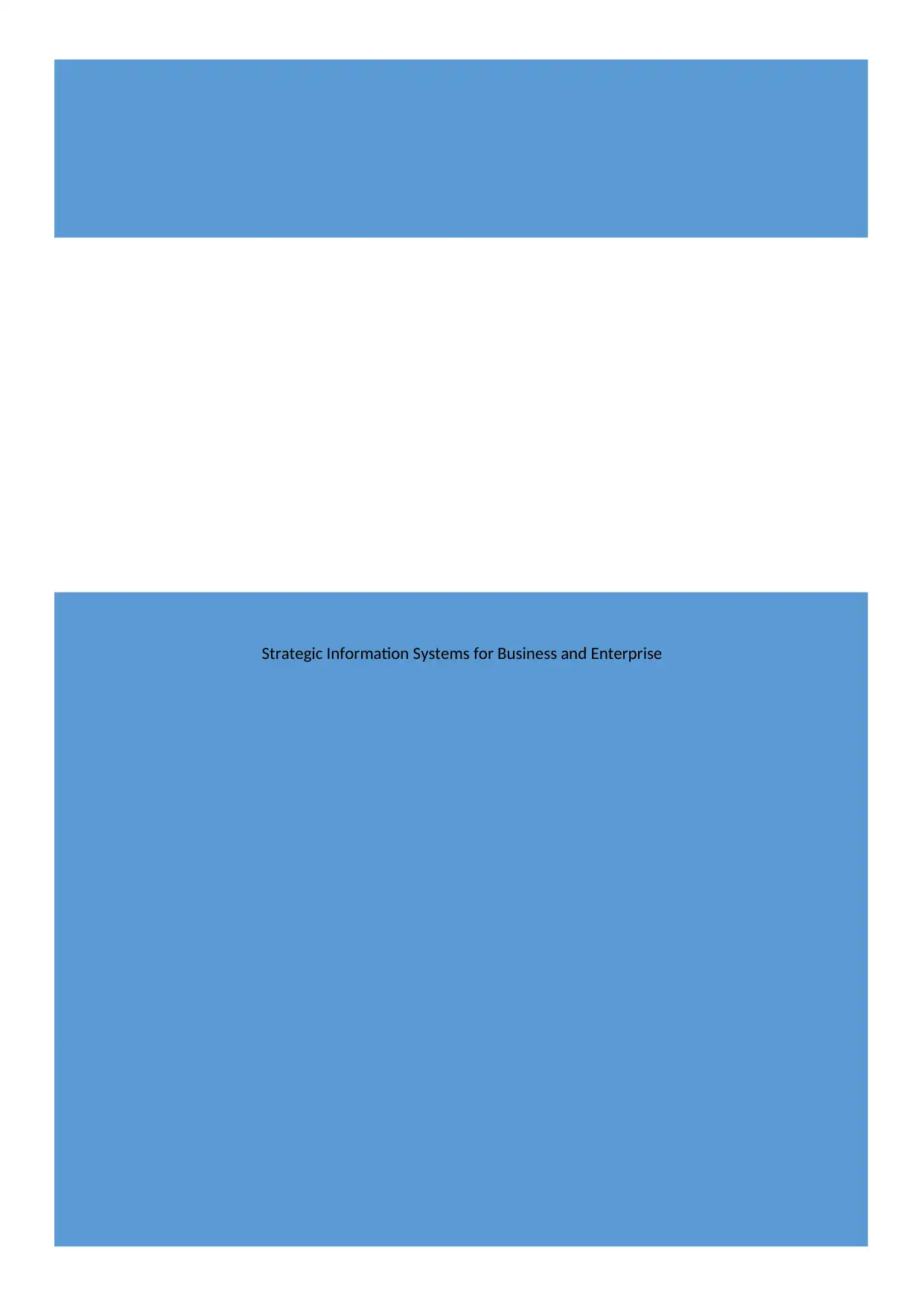
Strategic Information Systems for Business and Enterprise
Paraphrase This Document
Need a fresh take? Get an instant paraphrase of this document with our AI Paraphraser
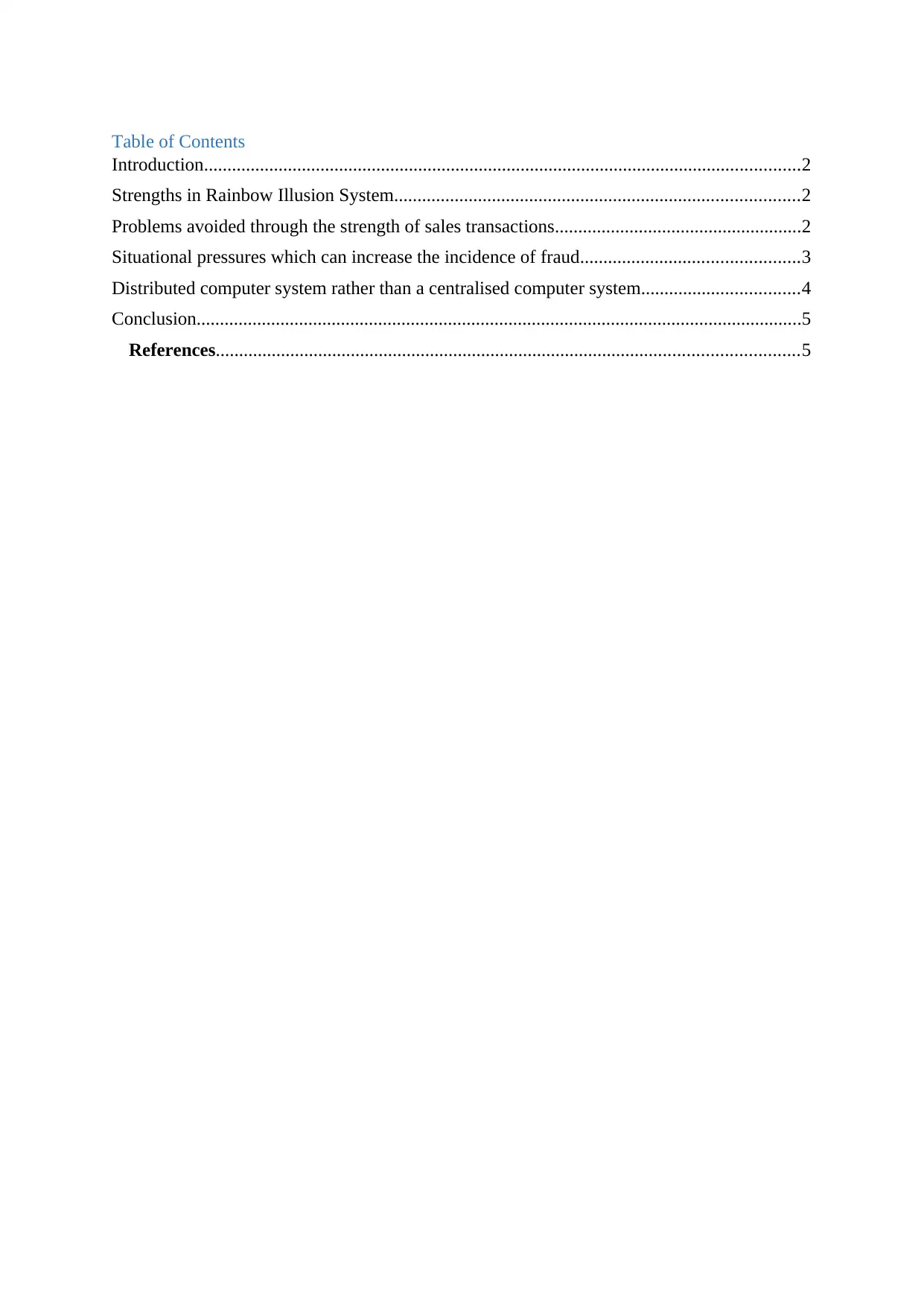
Table of Contents
Introduction................................................................................................................................2
Strengths in Rainbow Illusion System.......................................................................................2
Problems avoided through the strength of sales transactions.....................................................2
Situational pressures which can increase the incidence of fraud...............................................3
Distributed computer system rather than a centralised computer system..................................4
Conclusion..................................................................................................................................5
References.............................................................................................................................5
Introduction................................................................................................................................2
Strengths in Rainbow Illusion System.......................................................................................2
Problems avoided through the strength of sales transactions.....................................................2
Situational pressures which can increase the incidence of fraud...............................................3
Distributed computer system rather than a centralised computer system..................................4
Conclusion..................................................................................................................................5
References.............................................................................................................................5
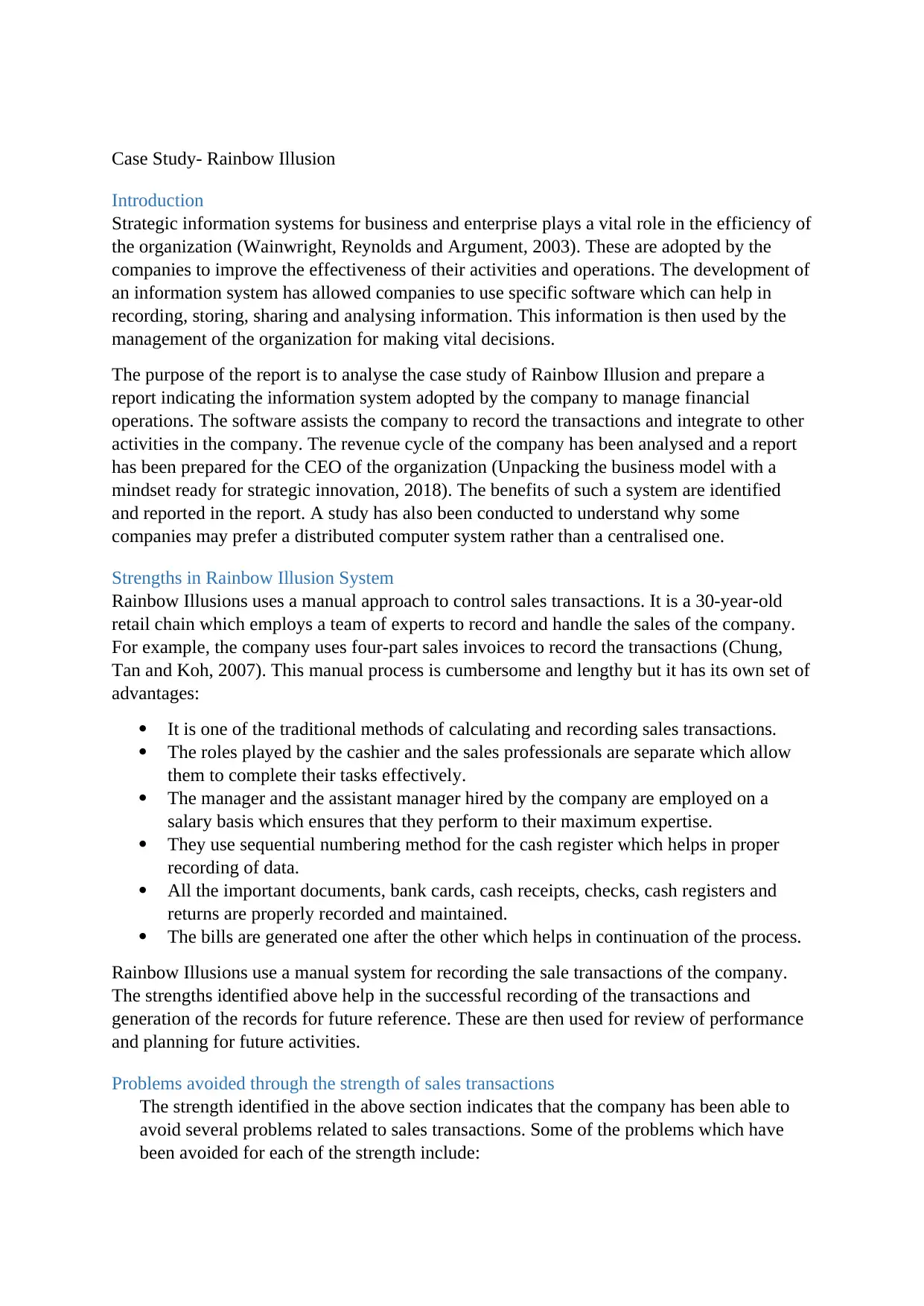
Case Study- Rainbow Illusion
Introduction
Strategic information systems for business and enterprise plays a vital role in the efficiency of
the organization (Wainwright, Reynolds and Argument, 2003). These are adopted by the
companies to improve the effectiveness of their activities and operations. The development of
an information system has allowed companies to use specific software which can help in
recording, storing, sharing and analysing information. This information is then used by the
management of the organization for making vital decisions.
The purpose of the report is to analyse the case study of Rainbow Illusion and prepare a
report indicating the information system adopted by the company to manage financial
operations. The software assists the company to record the transactions and integrate to other
activities in the company. The revenue cycle of the company has been analysed and a report
has been prepared for the CEO of the organization (Unpacking the business model with a
mindset ready for strategic innovation, 2018). The benefits of such a system are identified
and reported in the report. A study has also been conducted to understand why some
companies may prefer a distributed computer system rather than a centralised one.
Strengths in Rainbow Illusion System
Rainbow Illusions uses a manual approach to control sales transactions. It is a 30-year-old
retail chain which employs a team of experts to record and handle the sales of the company.
For example, the company uses four-part sales invoices to record the transactions (Chung,
Tan and Koh, 2007). This manual process is cumbersome and lengthy but it has its own set of
advantages:
It is one of the traditional methods of calculating and recording sales transactions.
The roles played by the cashier and the sales professionals are separate which allow
them to complete their tasks effectively.
The manager and the assistant manager hired by the company are employed on a
salary basis which ensures that they perform to their maximum expertise.
They use sequential numbering method for the cash register which helps in proper
recording of data.
All the important documents, bank cards, cash receipts, checks, cash registers and
returns are properly recorded and maintained.
The bills are generated one after the other which helps in continuation of the process.
Rainbow Illusions use a manual system for recording the sale transactions of the company.
The strengths identified above help in the successful recording of the transactions and
generation of the records for future reference. These are then used for review of performance
and planning for future activities.
Problems avoided through the strength of sales transactions
The strength identified in the above section indicates that the company has been able to
avoid several problems related to sales transactions. Some of the problems which have
been avoided for each of the strength include:
Introduction
Strategic information systems for business and enterprise plays a vital role in the efficiency of
the organization (Wainwright, Reynolds and Argument, 2003). These are adopted by the
companies to improve the effectiveness of their activities and operations. The development of
an information system has allowed companies to use specific software which can help in
recording, storing, sharing and analysing information. This information is then used by the
management of the organization for making vital decisions.
The purpose of the report is to analyse the case study of Rainbow Illusion and prepare a
report indicating the information system adopted by the company to manage financial
operations. The software assists the company to record the transactions and integrate to other
activities in the company. The revenue cycle of the company has been analysed and a report
has been prepared for the CEO of the organization (Unpacking the business model with a
mindset ready for strategic innovation, 2018). The benefits of such a system are identified
and reported in the report. A study has also been conducted to understand why some
companies may prefer a distributed computer system rather than a centralised one.
Strengths in Rainbow Illusion System
Rainbow Illusions uses a manual approach to control sales transactions. It is a 30-year-old
retail chain which employs a team of experts to record and handle the sales of the company.
For example, the company uses four-part sales invoices to record the transactions (Chung,
Tan and Koh, 2007). This manual process is cumbersome and lengthy but it has its own set of
advantages:
It is one of the traditional methods of calculating and recording sales transactions.
The roles played by the cashier and the sales professionals are separate which allow
them to complete their tasks effectively.
The manager and the assistant manager hired by the company are employed on a
salary basis which ensures that they perform to their maximum expertise.
They use sequential numbering method for the cash register which helps in proper
recording of data.
All the important documents, bank cards, cash receipts, checks, cash registers and
returns are properly recorded and maintained.
The bills are generated one after the other which helps in continuation of the process.
Rainbow Illusions use a manual system for recording the sale transactions of the company.
The strengths identified above help in the successful recording of the transactions and
generation of the records for future reference. These are then used for review of performance
and planning for future activities.
Problems avoided through the strength of sales transactions
The strength identified in the above section indicates that the company has been able to
avoid several problems related to sales transactions. Some of the problems which have
been avoided for each of the strength include:
⊘ This is a preview!⊘
Do you want full access?
Subscribe today to unlock all pages.

Trusted by 1+ million students worldwide
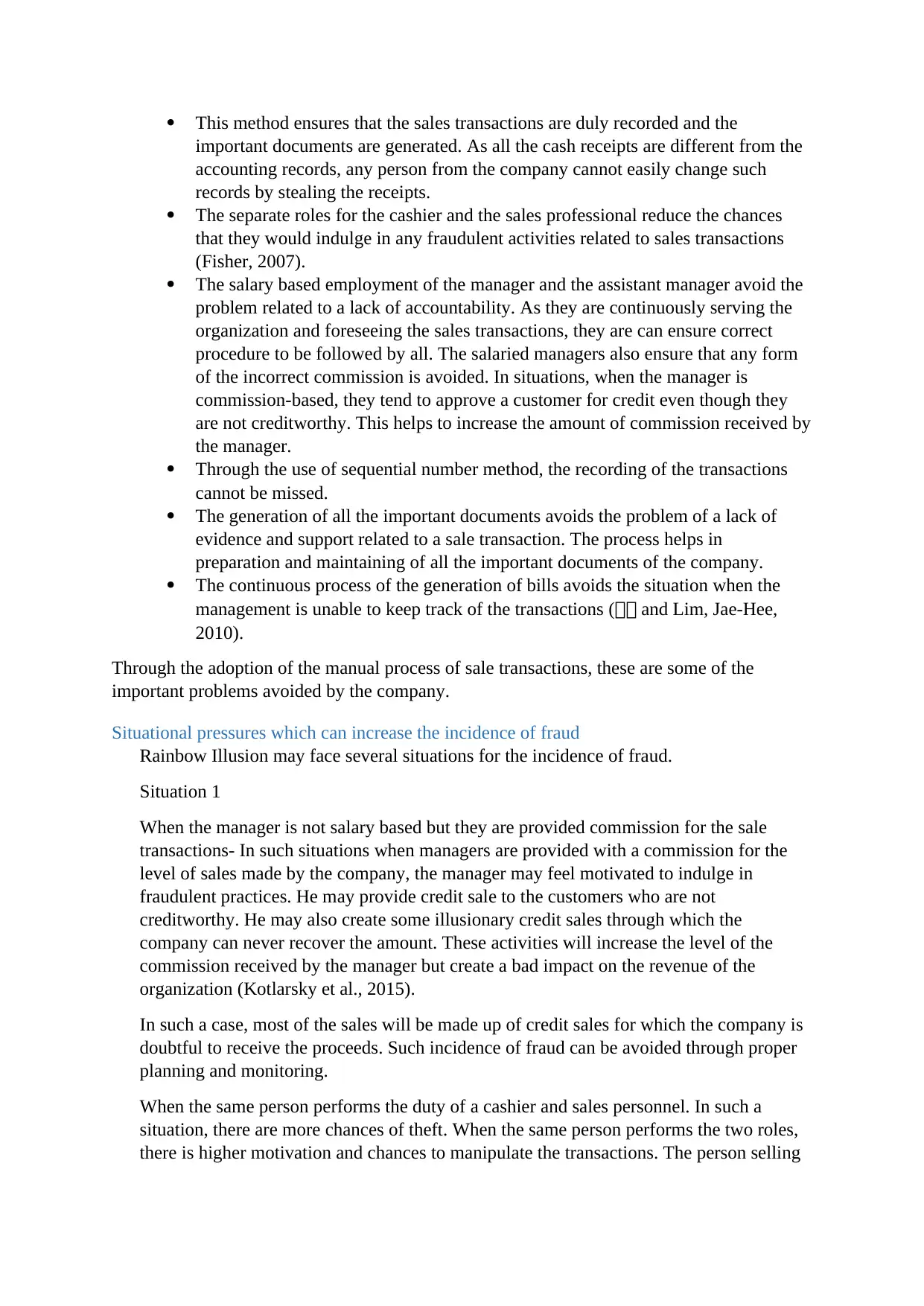
This method ensures that the sales transactions are duly recorded and the
important documents are generated. As all the cash receipts are different from the
accounting records, any person from the company cannot easily change such
records by stealing the receipts.
The separate roles for the cashier and the sales professional reduce the chances
that they would indulge in any fraudulent activities related to sales transactions
(Fisher, 2007).
The salary based employment of the manager and the assistant manager avoid the
problem related to a lack of accountability. As they are continuously serving the
organization and foreseeing the sales transactions, they are can ensure correct
procedure to be followed by all. The salaried managers also ensure that any form
of the incorrect commission is avoided. In situations, when the manager is
commission-based, they tend to approve a customer for credit even though they
are not creditworthy. This helps to increase the amount of commission received by
the manager.
Through the use of sequential number method, the recording of the transactions
cannot be missed.
The generation of all the important documents avoids the problem of a lack of
evidence and support related to a sale transaction. The process helps in
preparation and maintaining of all the important documents of the company.
The continuous process of the generation of bills avoids the situation when the
management is unable to keep track of the transactions (로로 and Lim, Jae-Hee,
2010).
Through the adoption of the manual process of sale transactions, these are some of the
important problems avoided by the company.
Situational pressures which can increase the incidence of fraud
Rainbow Illusion may face several situations for the incidence of fraud.
Situation 1
When the manager is not salary based but they are provided commission for the sale
transactions- In such situations when managers are provided with a commission for the
level of sales made by the company, the manager may feel motivated to indulge in
fraudulent practices. He may provide credit sale to the customers who are not
creditworthy. He may also create some illusionary credit sales through which the
company can never recover the amount. These activities will increase the level of the
commission received by the manager but create a bad impact on the revenue of the
organization (Kotlarsky et al., 2015).
In such a case, most of the sales will be made up of credit sales for which the company is
doubtful to receive the proceeds. Such incidence of fraud can be avoided through proper
planning and monitoring.
When the same person performs the duty of a cashier and sales personnel. In such a
situation, there are more chances of theft. When the same person performs the two roles,
there is higher motivation and chances to manipulate the transactions. The person selling
important documents are generated. As all the cash receipts are different from the
accounting records, any person from the company cannot easily change such
records by stealing the receipts.
The separate roles for the cashier and the sales professional reduce the chances
that they would indulge in any fraudulent activities related to sales transactions
(Fisher, 2007).
The salary based employment of the manager and the assistant manager avoid the
problem related to a lack of accountability. As they are continuously serving the
organization and foreseeing the sales transactions, they are can ensure correct
procedure to be followed by all. The salaried managers also ensure that any form
of the incorrect commission is avoided. In situations, when the manager is
commission-based, they tend to approve a customer for credit even though they
are not creditworthy. This helps to increase the amount of commission received by
the manager.
Through the use of sequential number method, the recording of the transactions
cannot be missed.
The generation of all the important documents avoids the problem of a lack of
evidence and support related to a sale transaction. The process helps in
preparation and maintaining of all the important documents of the company.
The continuous process of the generation of bills avoids the situation when the
management is unable to keep track of the transactions (로로 and Lim, Jae-Hee,
2010).
Through the adoption of the manual process of sale transactions, these are some of the
important problems avoided by the company.
Situational pressures which can increase the incidence of fraud
Rainbow Illusion may face several situations for the incidence of fraud.
Situation 1
When the manager is not salary based but they are provided commission for the sale
transactions- In such situations when managers are provided with a commission for the
level of sales made by the company, the manager may feel motivated to indulge in
fraudulent practices. He may provide credit sale to the customers who are not
creditworthy. He may also create some illusionary credit sales through which the
company can never recover the amount. These activities will increase the level of the
commission received by the manager but create a bad impact on the revenue of the
organization (Kotlarsky et al., 2015).
In such a case, most of the sales will be made up of credit sales for which the company is
doubtful to receive the proceeds. Such incidence of fraud can be avoided through proper
planning and monitoring.
When the same person performs the duty of a cashier and sales personnel. In such a
situation, there are more chances of theft. When the same person performs the two roles,
there is higher motivation and chances to manipulate the transactions. The person selling
Paraphrase This Document
Need a fresh take? Get an instant paraphrase of this document with our AI Paraphraser
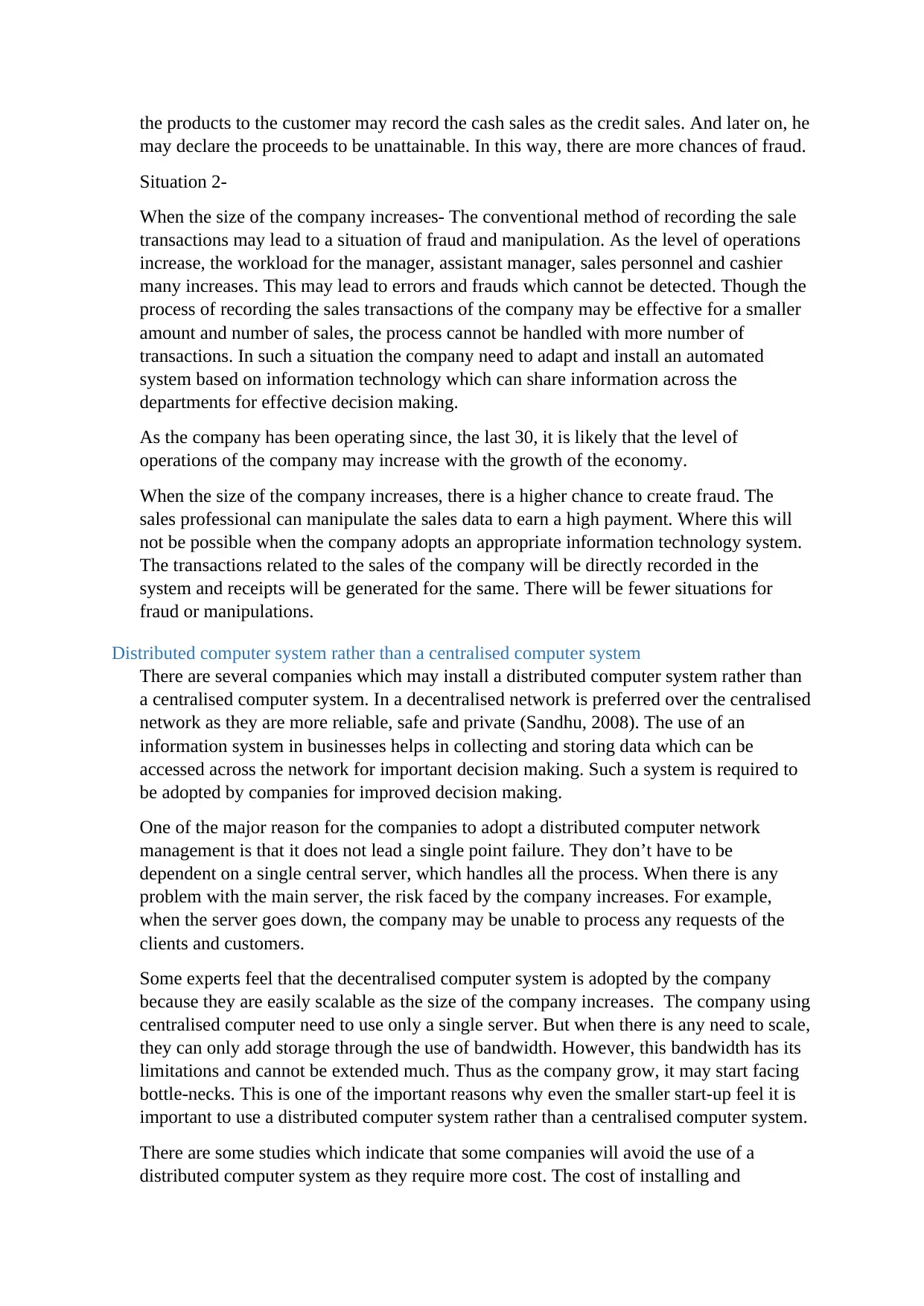
the products to the customer may record the cash sales as the credit sales. And later on, he
may declare the proceeds to be unattainable. In this way, there are more chances of fraud.
Situation 2-
When the size of the company increases- The conventional method of recording the sale
transactions may lead to a situation of fraud and manipulation. As the level of operations
increase, the workload for the manager, assistant manager, sales personnel and cashier
many increases. This may lead to errors and frauds which cannot be detected. Though the
process of recording the sales transactions of the company may be effective for a smaller
amount and number of sales, the process cannot be handled with more number of
transactions. In such a situation the company need to adapt and install an automated
system based on information technology which can share information across the
departments for effective decision making.
As the company has been operating since, the last 30, it is likely that the level of
operations of the company may increase with the growth of the economy.
When the size of the company increases, there is a higher chance to create fraud. The
sales professional can manipulate the sales data to earn a high payment. Where this will
not be possible when the company adopts an appropriate information technology system.
The transactions related to the sales of the company will be directly recorded in the
system and receipts will be generated for the same. There will be fewer situations for
fraud or manipulations.
Distributed computer system rather than a centralised computer system
There are several companies which may install a distributed computer system rather than
a centralised computer system. In a decentralised network is preferred over the centralised
network as they are more reliable, safe and private (Sandhu, 2008). The use of an
information system in businesses helps in collecting and storing data which can be
accessed across the network for important decision making. Such a system is required to
be adopted by companies for improved decision making.
One of the major reason for the companies to adopt a distributed computer network
management is that it does not lead a single point failure. They don’t have to be
dependent on a single central server, which handles all the process. When there is any
problem with the main server, the risk faced by the company increases. For example,
when the server goes down, the company may be unable to process any requests of the
clients and customers.
Some experts feel that the decentralised computer system is adopted by the company
because they are easily scalable as the size of the company increases. The company using
centralised computer need to use only a single server. But when there is any need to scale,
they can only add storage through the use of bandwidth. However, this bandwidth has its
limitations and cannot be extended much. Thus as the company grow, it may start facing
bottle-necks. This is one of the important reasons why even the smaller start-up feel it is
important to use a distributed computer system rather than a centralised computer system.
There are some studies which indicate that some companies will avoid the use of a
distributed computer system as they require more cost. The cost of installing and
may declare the proceeds to be unattainable. In this way, there are more chances of fraud.
Situation 2-
When the size of the company increases- The conventional method of recording the sale
transactions may lead to a situation of fraud and manipulation. As the level of operations
increase, the workload for the manager, assistant manager, sales personnel and cashier
many increases. This may lead to errors and frauds which cannot be detected. Though the
process of recording the sales transactions of the company may be effective for a smaller
amount and number of sales, the process cannot be handled with more number of
transactions. In such a situation the company need to adapt and install an automated
system based on information technology which can share information across the
departments for effective decision making.
As the company has been operating since, the last 30, it is likely that the level of
operations of the company may increase with the growth of the economy.
When the size of the company increases, there is a higher chance to create fraud. The
sales professional can manipulate the sales data to earn a high payment. Where this will
not be possible when the company adopts an appropriate information technology system.
The transactions related to the sales of the company will be directly recorded in the
system and receipts will be generated for the same. There will be fewer situations for
fraud or manipulations.
Distributed computer system rather than a centralised computer system
There are several companies which may install a distributed computer system rather than
a centralised computer system. In a decentralised network is preferred over the centralised
network as they are more reliable, safe and private (Sandhu, 2008). The use of an
information system in businesses helps in collecting and storing data which can be
accessed across the network for important decision making. Such a system is required to
be adopted by companies for improved decision making.
One of the major reason for the companies to adopt a distributed computer network
management is that it does not lead a single point failure. They don’t have to be
dependent on a single central server, which handles all the process. When there is any
problem with the main server, the risk faced by the company increases. For example,
when the server goes down, the company may be unable to process any requests of the
clients and customers.
Some experts feel that the decentralised computer system is adopted by the company
because they are easily scalable as the size of the company increases. The company using
centralised computer need to use only a single server. But when there is any need to scale,
they can only add storage through the use of bandwidth. However, this bandwidth has its
limitations and cannot be extended much. Thus as the company grow, it may start facing
bottle-necks. This is one of the important reasons why even the smaller start-up feel it is
important to use a distributed computer system rather than a centralised computer system.
There are some studies which indicate that some companies will avoid the use of a
distributed computer system as they require more cost. The cost of installing and
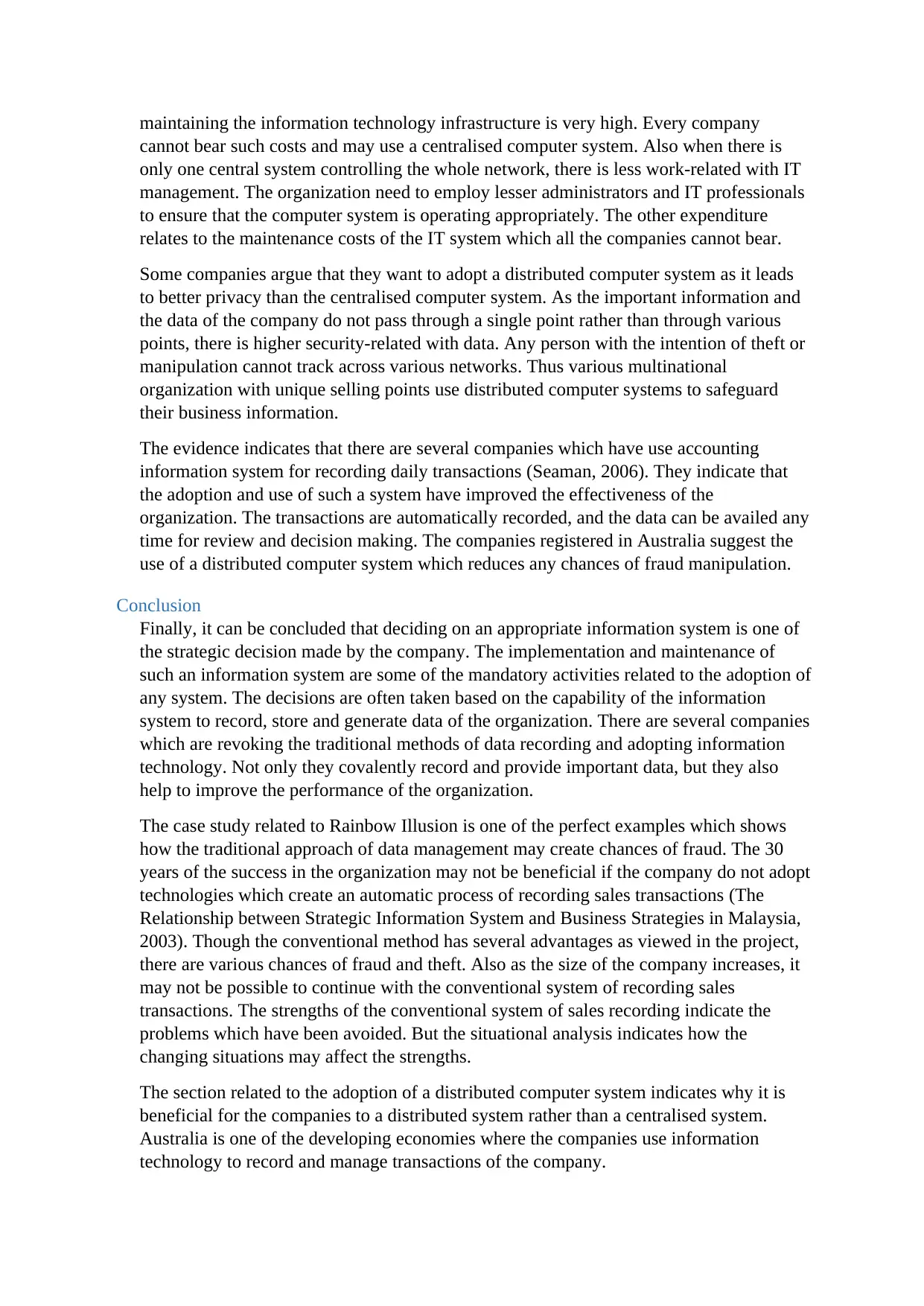
maintaining the information technology infrastructure is very high. Every company
cannot bear such costs and may use a centralised computer system. Also when there is
only one central system controlling the whole network, there is less work-related with IT
management. The organization need to employ lesser administrators and IT professionals
to ensure that the computer system is operating appropriately. The other expenditure
relates to the maintenance costs of the IT system which all the companies cannot bear.
Some companies argue that they want to adopt a distributed computer system as it leads
to better privacy than the centralised computer system. As the important information and
the data of the company do not pass through a single point rather than through various
points, there is higher security-related with data. Any person with the intention of theft or
manipulation cannot track across various networks. Thus various multinational
organization with unique selling points use distributed computer systems to safeguard
their business information.
The evidence indicates that there are several companies which have use accounting
information system for recording daily transactions (Seaman, 2006). They indicate that
the adoption and use of such a system have improved the effectiveness of the
organization. The transactions are automatically recorded, and the data can be availed any
time for review and decision making. The companies registered in Australia suggest the
use of a distributed computer system which reduces any chances of fraud manipulation.
Conclusion
Finally, it can be concluded that deciding on an appropriate information system is one of
the strategic decision made by the company. The implementation and maintenance of
such an information system are some of the mandatory activities related to the adoption of
any system. The decisions are often taken based on the capability of the information
system to record, store and generate data of the organization. There are several companies
which are revoking the traditional methods of data recording and adopting information
technology. Not only they covalently record and provide important data, but they also
help to improve the performance of the organization.
The case study related to Rainbow Illusion is one of the perfect examples which shows
how the traditional approach of data management may create chances of fraud. The 30
years of the success in the organization may not be beneficial if the company do not adopt
technologies which create an automatic process of recording sales transactions (The
Relationship between Strategic Information System and Business Strategies in Malaysia,
2003). Though the conventional method has several advantages as viewed in the project,
there are various chances of fraud and theft. Also as the size of the company increases, it
may not be possible to continue with the conventional system of recording sales
transactions. The strengths of the conventional system of sales recording indicate the
problems which have been avoided. But the situational analysis indicates how the
changing situations may affect the strengths.
The section related to the adoption of a distributed computer system indicates why it is
beneficial for the companies to a distributed system rather than a centralised system.
Australia is one of the developing economies where the companies use information
technology to record and manage transactions of the company.
cannot bear such costs and may use a centralised computer system. Also when there is
only one central system controlling the whole network, there is less work-related with IT
management. The organization need to employ lesser administrators and IT professionals
to ensure that the computer system is operating appropriately. The other expenditure
relates to the maintenance costs of the IT system which all the companies cannot bear.
Some companies argue that they want to adopt a distributed computer system as it leads
to better privacy than the centralised computer system. As the important information and
the data of the company do not pass through a single point rather than through various
points, there is higher security-related with data. Any person with the intention of theft or
manipulation cannot track across various networks. Thus various multinational
organization with unique selling points use distributed computer systems to safeguard
their business information.
The evidence indicates that there are several companies which have use accounting
information system for recording daily transactions (Seaman, 2006). They indicate that
the adoption and use of such a system have improved the effectiveness of the
organization. The transactions are automatically recorded, and the data can be availed any
time for review and decision making. The companies registered in Australia suggest the
use of a distributed computer system which reduces any chances of fraud manipulation.
Conclusion
Finally, it can be concluded that deciding on an appropriate information system is one of
the strategic decision made by the company. The implementation and maintenance of
such an information system are some of the mandatory activities related to the adoption of
any system. The decisions are often taken based on the capability of the information
system to record, store and generate data of the organization. There are several companies
which are revoking the traditional methods of data recording and adopting information
technology. Not only they covalently record and provide important data, but they also
help to improve the performance of the organization.
The case study related to Rainbow Illusion is one of the perfect examples which shows
how the traditional approach of data management may create chances of fraud. The 30
years of the success in the organization may not be beneficial if the company do not adopt
technologies which create an automatic process of recording sales transactions (The
Relationship between Strategic Information System and Business Strategies in Malaysia,
2003). Though the conventional method has several advantages as viewed in the project,
there are various chances of fraud and theft. Also as the size of the company increases, it
may not be possible to continue with the conventional system of recording sales
transactions. The strengths of the conventional system of sales recording indicate the
problems which have been avoided. But the situational analysis indicates how the
changing situations may affect the strengths.
The section related to the adoption of a distributed computer system indicates why it is
beneficial for the companies to a distributed system rather than a centralised system.
Australia is one of the developing economies where the companies use information
technology to record and manage transactions of the company.
⊘ This is a preview!⊘
Do you want full access?
Subscribe today to unlock all pages.

Trusted by 1+ million students worldwide
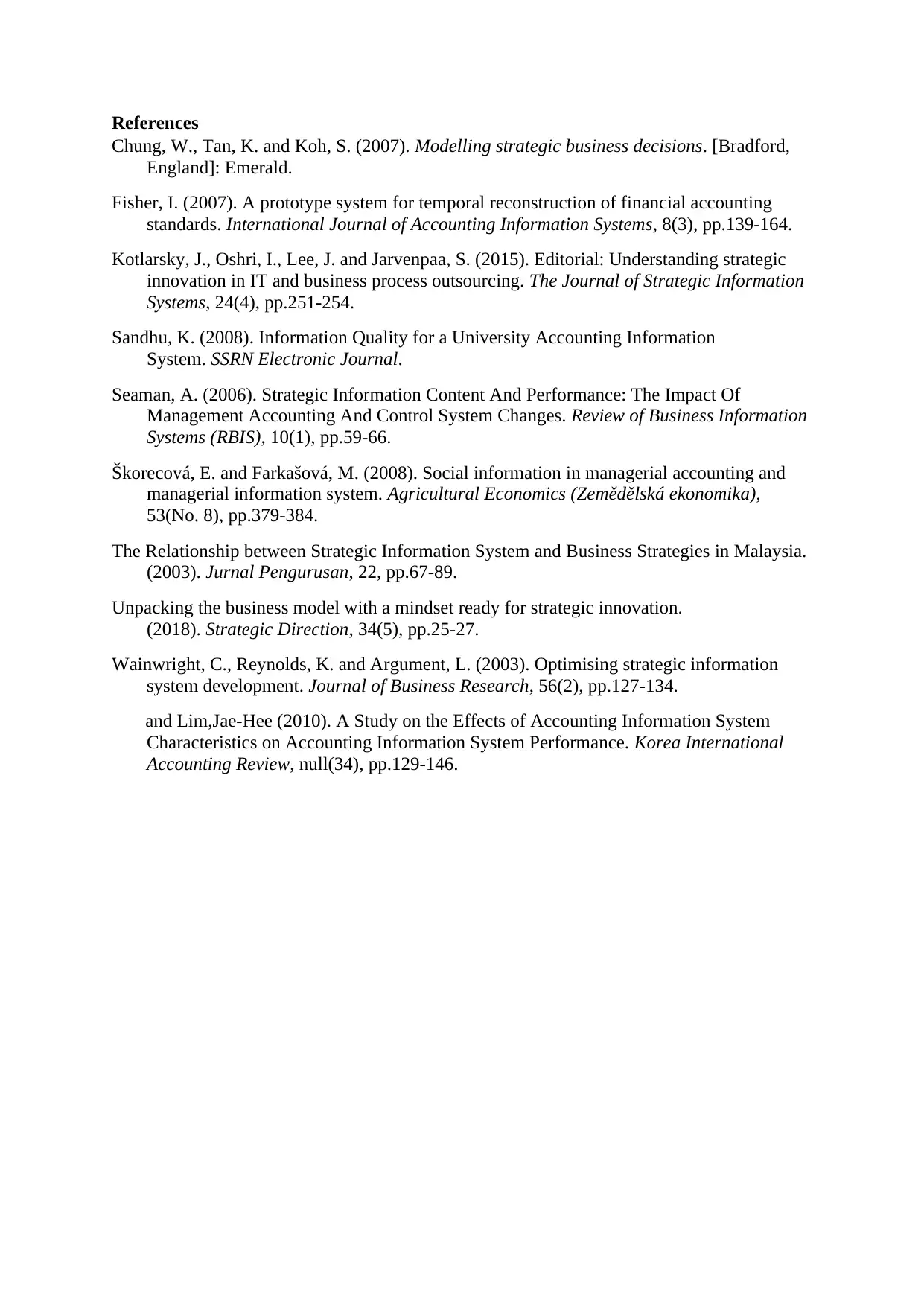
References
Chung, W., Tan, K. and Koh, S. (2007). Modelling strategic business decisions. [Bradford,
England]: Emerald.
Fisher, I. (2007). A prototype system for temporal reconstruction of financial accounting
standards. International Journal of Accounting Information Systems, 8(3), pp.139-164.
Kotlarsky, J., Oshri, I., Lee, J. and Jarvenpaa, S. (2015). Editorial: Understanding strategic
innovation in IT and business process outsourcing. The Journal of Strategic Information
Systems, 24(4), pp.251-254.
Sandhu, K. (2008). Information Quality for a University Accounting Information
System. SSRN Electronic Journal.
Seaman, A. (2006). Strategic Information Content And Performance: The Impact Of
Management Accounting And Control System Changes. Review of Business Information
Systems (RBIS), 10(1), pp.59-66.
Škorecová, E. and Farkašová, M. (2008). Social information in managerial accounting and
managerial information system. Agricultural Economics (Zemědělská ekonomika),
53(No. 8), pp.379-384.
The Relationship between Strategic Information System and Business Strategies in Malaysia.
(2003). Jurnal Pengurusan, 22, pp.67-89.
Unpacking the business model with a mindset ready for strategic innovation.
(2018). Strategic Direction, 34(5), pp.25-27.
Wainwright, C., Reynolds, K. and Argument, L. (2003). Optimising strategic information
system development. Journal of Business Research, 56(2), pp.127-134.
로로 and Lim,Jae-Hee (2010). A Study on the Effects of Accounting Information System
Characteristics on Accounting Information System Performance. Korea International
Accounting Review, null(34), pp.129-146.
Chung, W., Tan, K. and Koh, S. (2007). Modelling strategic business decisions. [Bradford,
England]: Emerald.
Fisher, I. (2007). A prototype system for temporal reconstruction of financial accounting
standards. International Journal of Accounting Information Systems, 8(3), pp.139-164.
Kotlarsky, J., Oshri, I., Lee, J. and Jarvenpaa, S. (2015). Editorial: Understanding strategic
innovation in IT and business process outsourcing. The Journal of Strategic Information
Systems, 24(4), pp.251-254.
Sandhu, K. (2008). Information Quality for a University Accounting Information
System. SSRN Electronic Journal.
Seaman, A. (2006). Strategic Information Content And Performance: The Impact Of
Management Accounting And Control System Changes. Review of Business Information
Systems (RBIS), 10(1), pp.59-66.
Škorecová, E. and Farkašová, M. (2008). Social information in managerial accounting and
managerial information system. Agricultural Economics (Zemědělská ekonomika),
53(No. 8), pp.379-384.
The Relationship between Strategic Information System and Business Strategies in Malaysia.
(2003). Jurnal Pengurusan, 22, pp.67-89.
Unpacking the business model with a mindset ready for strategic innovation.
(2018). Strategic Direction, 34(5), pp.25-27.
Wainwright, C., Reynolds, K. and Argument, L. (2003). Optimising strategic information
system development. Journal of Business Research, 56(2), pp.127-134.
로로 and Lim,Jae-Hee (2010). A Study on the Effects of Accounting Information System
Characteristics on Accounting Information System Performance. Korea International
Accounting Review, null(34), pp.129-146.
1 out of 7
Related Documents
Your All-in-One AI-Powered Toolkit for Academic Success.
+13062052269
info@desklib.com
Available 24*7 on WhatsApp / Email
![[object Object]](/_next/static/media/star-bottom.7253800d.svg)
Unlock your academic potential
Copyright © 2020–2025 A2Z Services. All Rights Reserved. Developed and managed by ZUCOL.





